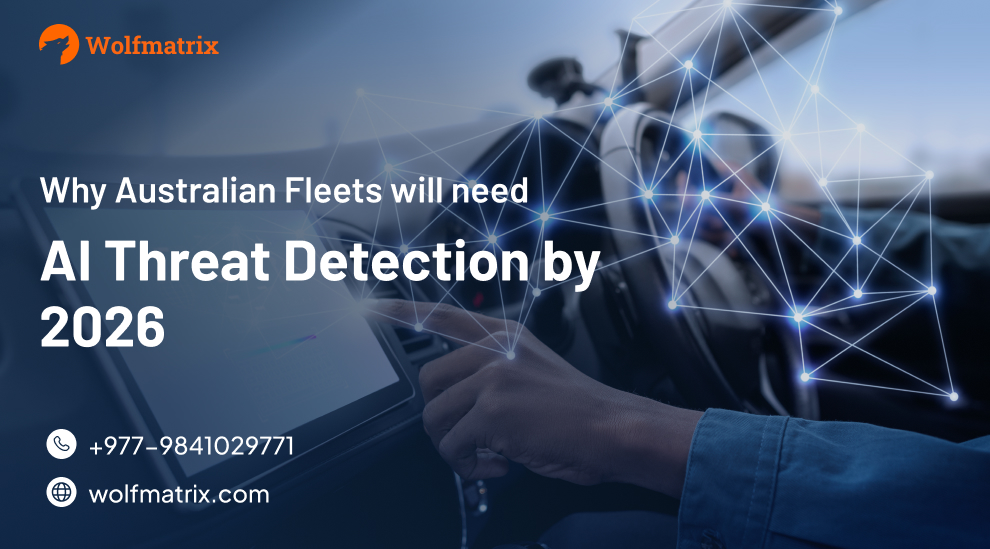AI threat detection for fleets in Australia is rapidly becoming indispensable. As transport fleets evolve into highly connected, data-driven ecosystems, their vulnerability to cyber threats multiplies making intelligent defense not optional, but essential.
Why Australian Fleets will face a Cyber Crisis ahead
Australia is seeing AI-enhanced cybercrime on the rise:
AI-powered phishing surged, with Australia ranked 8th globally over 30 million phishing attempts in 2024 alone.
78% of Australian organizations reported impact from AI-based cyber threats, yet more than half remain unprepared according to Australian Cyber Security Magazine
Phishing, credential compromise, and ransomware caused major disruptions across transport and infrastructure companies in FY2022-23.
With the government’s Cyber Security Strategy pushing enhanced AI governance by 2026, fleets without intelligent threat detection tools risk becoming easy targets. Major reports suggest over 90% of fleets will require AI-driven detection to stay resilient.
What is AI Threat Detection for Fleets in Australia?
Fleet cybersecurity is no longer just protecting backend systems, it now encompasses:
Continuous monitoring of telematics, GPS, and ECU data
Machine learning models identifying abnormal access or device behavior
Real-time correlation of threat signals using external threat intelligence feeds
This is the capability that allows fleets to detect social engineering attacks, zero-day intrusion, or covert network compromises before disruption.
Case for Fleet-Level Cyber Protection by 2026
Transport fleets often operate as critical infrastructure. According to ASD, over 11% of cyber incidents in FY2022‑23 affected infrastructure firms including transport. As fleets grow smarter and more connected, the attack surface increases.
AI can stop threats at machine-speed far faster than human teams. That’s why leading Australian organisations are beginning to deploy AI-powered tools like Microsoft’s Copilot for Security, which correlates events at scale and responds autonomously.
Benefits of AI Threat Detection for Fleets in Australia
Early Intrusion Detection
AI models detect unusual telemetry or access patterns before full breach or ransomware execution.
Automated Incident Responses
Smart systems can block or quarantine affected endpoints, limit lateral movement, and alert SOC teams with actionable intelligence.
Phishing & Deepfake Defense
Advanced threat detection flags voice phishing and email forgery attempts—essential in sectors where “vishing” has compromised millions of Qantas customers.
Fleet Trust & Data Sovereignty
According to Australian Cyber Security Magazine, 78% of organisations demand AI systems that retain data internally—helping mitigate cross-border risk and increasing compliance confidence.
Implementing AI Threat Detection for Fleets
Conduct a risk assessment — audit vehicle networks, TCU endpoints, and vendor access logs
Deploy lightweight edge agents — capture logs and telemetry for anomaly detection
Adopt zero-trust architecture — enforce continuous authentication and segmentation
Integrate fleet telemetry into SOC — ensure real-time threat feed ingestion and correlation
Train staff on evolving threats — including AI phishing, identity spoofing, and operational deception
How the Threat Detection Market is Scaling
The global AI cybersecurity market is projected to rise from US $24 billion in 2023 to US $134 billion by 2030.
In Australia, 41% of organisations are already investing in AI for network and cloud security protection—even before legal mandates arrive.
Over 1,100 cyber incidents reported to the ACSC in 2023‑24 reemphasise the urgency of real-time threat systems.
AI threat detection for fleets in Australia isn’t a future trend, it’s a rapidly emerging necessity. With AI-enabled adversaries on the rise and 78% of organisations already feeling vulnerable, fleets without automated defensive systems will struggle to stay operational and compliant. If you’re not planning to deploy AI threat detection by 2026, your fleet may be caught flat-footed in a rapidly shifting cyber battlefield.
Need help building actionable, resilient cybersecurity for your transport operations? Contact us to future-proof your fleet today.




